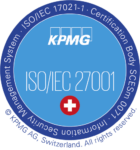The Advanced Electronic Signature – the golden middle ground between SES and QES
There are three different security levels for electronic signatures. The middle level (Advanced Electronic Signature – AES) offers more security than the SES.
Swiss and European laws recognise three different types of electronic signatures: the Simple Electronic Signature (SES), the Advanced Electronic Signature (AES), and the Qualified Electronic Signature (QES). The simplest version is suitable for everyday use, it is cost-effective, and provides a fair level of security. The Qualified Electronic Signature is equivalent to a handwritten signature on paper, and it can be used whenever the law requires a manual signature on paper. It offers the highest level of security but it is also more expensive.
The Advanced Electronic Signature falls between the SES and the QES in terms of both security and cost. An AES bears a timestamp proving that the signed document has not been altered. Additionally, the AES enables authentication of the signer. Identification is carried out using DeepID, through a highly secure process in which a camera image is compared with an official ID document (passport or ID card). Alternatively, authentication can be achieved via a simple text message confirmation, which is widely used today in many login processes to enhance security. This ensures that the recipient of an electronically signed document can know who signed it and that no alteration occurred.
In Switzerland, the written form is rarely required for the finalisation of contracts. When contracts are signed digitally, secure digital signatures (AES or QES) are not mandatory. However, in many cases, the parties involved want to be able to prove in a blink that everybody is actually who they claim to be. Take for example rental and employment contracts or purchase and service agreements involving large sums of money. Another good example are contracts with a conflict risk. For instance, the so-called NDAs (Non-Disclosure Agreements), in which both parties commit to confidentiality. Mutual advanced signatures provide a certain level of professionalism, even if the discussion itself took place via email or on social media.

Enhanced digitalisation potential for companies and authorities
Compared to their potential, creating digital signatures is relatively cost-effective. Some examples: a property management company can fully digitise handling, filing, and management of all contracts. Apart from inspecting the apartment together, landlords and tenants no longer need to meet in person. Even viewing of the apartment itself could be digitised using modern tools like 3D room scans. The written form is required in specific rental processes provided for by law, such as a termination notice. Electronic signatures play a key role when such processes require digitalisation.
Employment contracts represent an even better example. An employer can invite future employees to identify themselves via DeepID and sign the contract with an advanced signature. In this way, they will have a digital ID right away and may be immediately integrated into the company’s digital structure. Creating advanced digital signatures is not complicated. DeepSign is integrated into standard software such as Word, email programs like Gmail or Outlook, and many business software solutions such as Abacus.
The use of the Advanced Electronic Signature, as an intermediate option between the Simple Electronic Signature and the Qualified Electronic Signature, is not yet widespread. However, it has the potential to promote digitalisation of certain business processes and drive modernisation of the economy.

